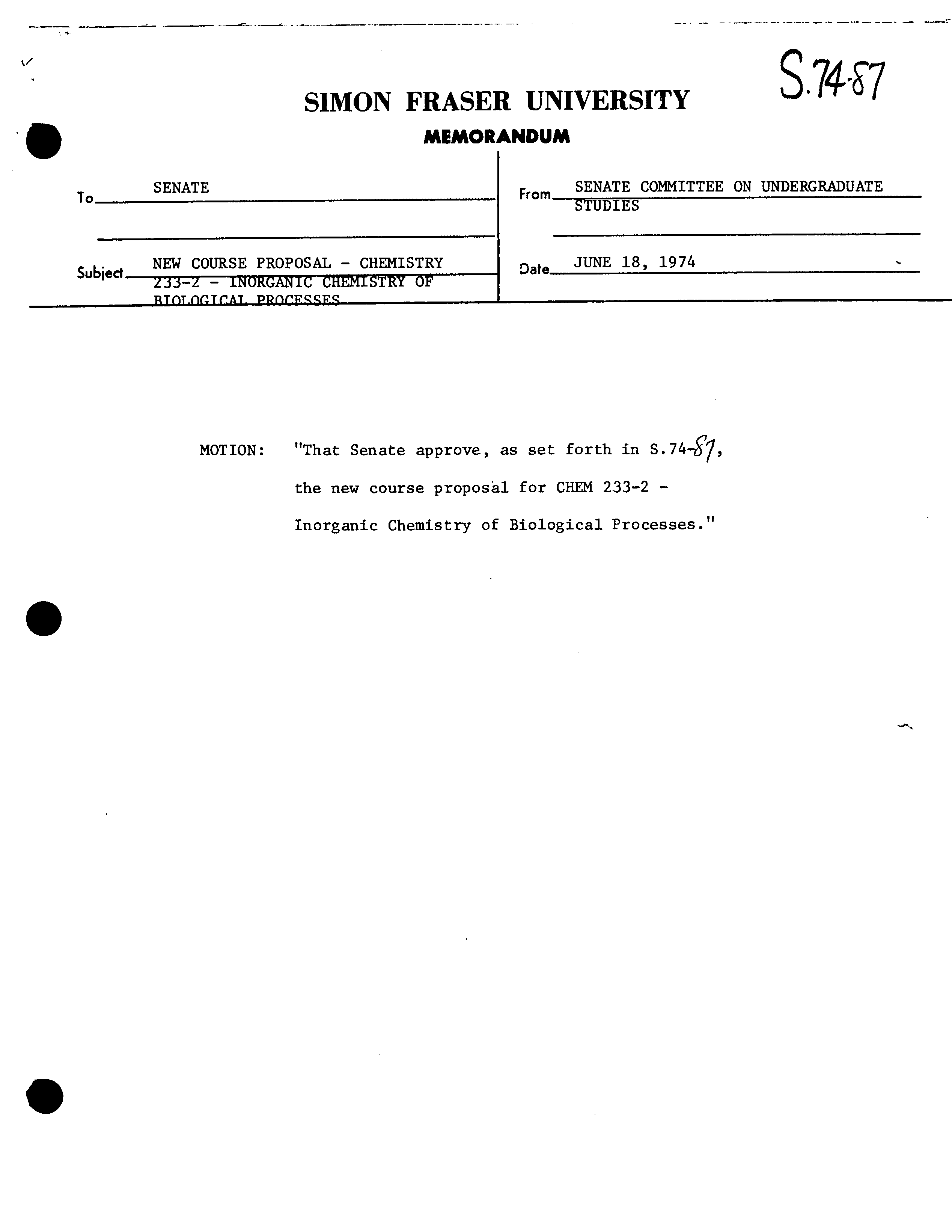SiMON FRASER UNIVERSITY
?
S.747
MEMORANDUM
To ?
SENATE
?
From SENATE COMMITTEE ON UNDERGRADUATE
STUDIES
Subject NEW COURSE PROPOSAL - CHEMISTRY
?
Date—JUNE 18, 1974
2i3-Z -
INORGANIC CHEMISTRY OF
T(TnT.n(2TrAT. PPfl('FP
MOTION: ?
"That Senate approve, as set forth in
the new course proposal for
CHEM 233-2 -
Inorganic Chemistry of Biological Processes."
.
V
SiMON FRASER UNIVERSITY
?
S-74T7
.
?
MEMORANDUM
To ?
SENATE
NEW COURSE PROPOSAL
Subject ..........
Chem
..
str . y
. ... 233-2 .... ......
....
From
SENATE Mrr1 a UNDERGRADUATE ?
IFS
Date.
June 18, 1974
At its meeting of 4th June, 1974, the Senate
Committee on Undergraduate Studies considered the attached
new course proposal for Chemistry 233-2 and recommends its
approval by Senate.
The documentation provided includes the
memorandum of transmittal to SCUS from the Faculty of Science,
the course proposal form and the course description. It should
be noted that, while this course will become part of the core
program in Bio-Chemistry (see section 3 of course proposal
form and P.1 of Bio-Chemistry proposal), it has been submitted
separately from that proposal since it is a purely departmental
course which has followed a different route to Senate from the
S
?
revisions in that program.
I. Mu ridge
ains
att.
0
SiMON FRASER UNIVERSITY
MEMORANDUM
lo ?
Senate Cominitteen
.
Undergat..u4..S
.
Sub ?
. NE1
C//Fr'/f77'Y .23?-2
The Faculty of Science at its meeting of April 9, 1974 approved
the attached new course proposal for Chemistry 233-2, Inorganic
Chemistry of Biological Processes and recommends its approval
by SCUS.
1w
cc: T. Bell, Chairman
Department of Chemistry
. ?
...
0
SENATE COMMITTEE ON UNDERGRADUATE STUDIES?
NEW COURSE PR01OSAL FORM
1. Calender Information
?
Department: ?
Chemistry
Abbreviation Code:
Chem
Course Number:
233
- Credit Hours;
2
Vector:
-
2-1-0
Title of Course:
?
Inorganic Chemistry of Biological Processes
Calendar Description of Course:
An introduction to the principles governing the formation,
properties, and investigation of metal-ligand complexes with
special reference to the role of metals in biological processes.
Nature of Course
Lecture
Prerequisites (or special instructions):
Chemistry
105-3.
It is recommended that Chem
251
precede or
be taken concurrently.
What course (courses), if any, is being dropped from the calendar if this course is
approved:
None. The frequency, of offering of Chem
232
will be reduced
if demand necessitates.
2. Scheduling
How frequently will
the course be offered?
Once per year initially
Semester in which the course will first be offered?
?
Fall
1975
. ?
Which of your present faculty would be available to make the proposed offering
possible? Profs. Sutton, Einstein, Peterson
3, Objectives of the Course
This is a core course in the biochemistry majors program;
designed to provide instruction in a sub-area of inorganic
chemistry of importance and applicability to biochemistry.
4.
Requirements
tary and Space
(for information only)
What additional resources will be required in the following- areas:
Faculty
?
Nil (Rearrangement of the Chemistry program offerings
Staff ?
'
Nil will permit CHEM 233 to be offered once per year
with existing faculty.)
Library
?
Nil
Audio Visual
Nil
Space
?
Lecture Room
Equipment ?
Nil
5.
Approval
Date:
Depar tmcnt)iu irman
?
Dean' ?
Chairman, SCUS
SCUS
• /3-34b;-
(When co:pleting this form, for instructions see Memorandum SCUS 73•-34a.
Attach coure outline).
V
0
Chemistry
233-2
Inorganic Chemistry of Biological Processes
Course Description
Lecture
?
1-4 ?
Background: main biological functions of metal ions;
oxidation states and electronic configurations of metal
ions; size relationships, salvation energies, entropies
and structure; complex formation, stability constants,
types of ligand, chelates.
?
5-10 ?
Group I and II ions Na, K, Mg and Ca: general properties;
distribution inside and outside cells; concentration
gradients, membrane selectivity and electrical potentials.
Selectivity of macrocyclic ligands (including antibiotics
and phosphoprotein) toward metal ions. The sodium and
calcium pumps. Trigger and control mechanisms utilising
Ca
2
, muscle contraction and nerve-impulse transmission.
?
11-1k ?
First-Row Transition-Metals M
2 and M 3
ions and their
. ?
general properties. Ligand field theory; high-spin/low-
spin complexes, visible spectra, octahedral and tetrahedral
complexes. Distortions from regular geometry, unusual
coordination numbers. Ligand-field stabilisation effects.
?
15-2
4 ?
Metal-.Activated Enzymes Metalloenzymes and metal-protein
complexes, general description and distinction. Metal-
binding sites, metal ion probes. Models for binding sites.
Hydrolytic metal-activated enzymes (carboxypeptidase-A
as detailed exam
p
le). Oxidation-Reduction metalloproteins,
electron-transport, heme and non-heme iron proteins, copper
proteins, cobalt B
12
coenzymes. Nitrogen fixation and
the nitrogen cycle. Oxygen carrier and storage metallo-
proteins, model for hemoglobin, synthetic oxygen carriers.
Student Text-Book•
None currently available specific to the course as a whole. Lectures
1-4
and 11-14, together with parts of
15-24
are covered by Huheey,
"Inorganic Chemistry
Teachers Text-Book
M.N. Hughes, The Inorganic Chemistry of Biological Processes".
0
